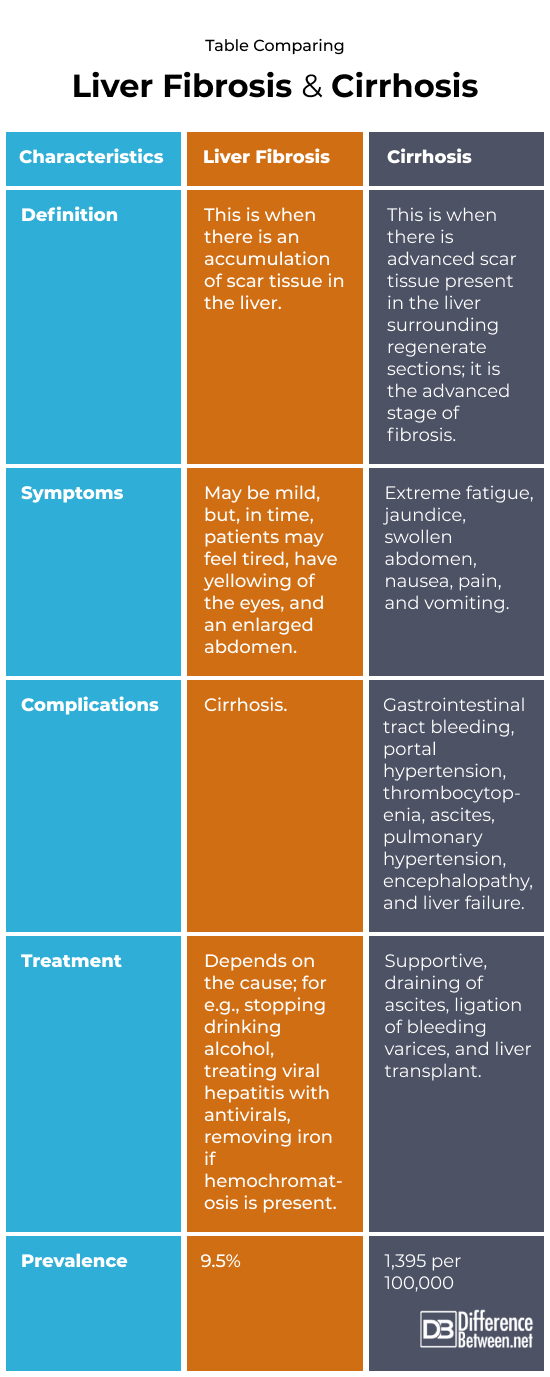Difference Between Liver Fibrosis and Cirrhosis
Liver fibrosis is when scarring happens to liver (hepatic) tissue due to injury to the liver. Cirrhosis is the most severe form of fibrosis.

What is Liver fibrosis?
Definition:
Liver fibrosis is a buildup of scar tissue made up of proteins that replaces healthy liver cells and tissue.
Causes and prevalence:
The cause of liver fibrosis is damage to the liver which may be due to chronic inflammation resulting from liver injury. Factors leading to fibrosis include having hemochromatosis, viral hepatitis (B or C), drinking alcohol, and developing nonalcoholic steatohepatitis (NASH). Liver fibrosis occurs in about 9.5% of people.
Symptoms and complications:
There may be no signs of fibrosis until it is quite far advanced. Patients may begin to feel very tired, have yellowing of the eyes, and an enlarged abdomen as fibrosis worsens.
Diagnosis:
Diagnosis relies on a physical exam and tests. Some of the tests that may be done include a liver biopsy, blood tests. A type of ultrasound, known as transient elastography is a more recent type of test that looks at how stiff the liver tissue is. This test can help in diagnosing fibrosis. The liver biopsy is still thought of today as the best way to determine fibrosis and indicate severity of the problem.
Treatment:
Treatment options for fibrosis really depends on why you have the problem. In certain cases, abstaining from alcohol can help. People with hepatitis can be given antivirals and those with hemochromatosis can undergo therapy to remove the excess iron.

What is Cirrhosis?
Definition:
Cirrhosis is a condition where there is advanced scar tissue and regenerative tissue found in the liver. It is also referred to as stage 4 fibrosis.
Causes and prevalence:
Liver cirrhosis is caused by anything that damages the liver. Some common causes include drinking alcohol, having a fatty liver such as NASH, and having either hepatitis B or hepatitis C. The prevalence varies by country but in the world, it is thought that about 1,395 cases occur for every 100,000 people.
Symptoms and complications:
Liver cirrhosis has several symptoms including the following: abdominal pain, nausea, vomiting, jaundice, loss of appetite, weight loss, itching skin, fluid buildup in the belly, enlarged liver, and yellowing of the eyes (jaundice). Several complications can occur, such as portal hypertension, pulmonary hypertension, bleeding of the gastrointestinal tract, liver failure, and death.
Diagnosis:
Liver cirrhosis is still best diagnosed by a liver biopsy, but other tests including ultrasound, MRI, and blood tests looking at liver enzyme levels are also done. Transient elastography is done to stage the level of cirrhosis and decide on a course of treatment.
Treatment:
Treatment is supportive and includes adding vitamin supplements. Ligation is often done to halt bleeding from the esophageal varices. Liver transplant may be recommended in severe cases.
Difference between Liver fibrosis and Cirrhosis
Definition
Liver fibrosis is when there is an accumulation of scar tissue in the liver. Cirrhosis is when there is advanced scar tissue present in the liver surrounding regenerative sections.
Symptoms
In the case of liver fibrosis, the symptoms may be mild or the patients may experience symptoms, such as jaundice, tiredness, and an enlarged abdomen. In the case of cirrhosis, the symptoms include fatigue, nausea, vomiting, jaundice, and swollen abdomen.
Complications
Cirrhosis is a complication of liver fibrosis. Complications of cirrhosis include: gastrointestinal tract bleeding, portal hypertension, thrombocytopenia (platelet problems), pulmonary hypertension, fluid buildup in the abdomen (ascites), encephalopathy, and liver failure.
Treatment
For fibrosis, treatment depends on the cause; for e.g., stopping drinking alcohol or treating viral hepatitis with antivirals. For cirrhosis, treatment is often supportive, but it can include draining of ascites, ligation of bleeding varices, and, in some cases, liver transplant.
Prevalence
Liver fibrosis occurs in about 9.5% of people. Liver cirrhosis occurs in about 1,395 people per 100,000.
Table comparing Liver fibrosis and Cirrhosis

Summary of Liver fibrosis Vs. Cirrhosis
- Liver fibrosis is scarring of hepatic tissue.
- There are many causes of fibrosis including drinking alcohol, certain medications, and viral infections.
- Cirrhosis is the very late stage of hepatic scarring that occurs.
- Cirrhosis can result in severe complications, with the person requiring a liver transplant.
FAQ
Does liver fibrosis always lead to cirrhosis?
No, it is only in some people where liver fibrosis worsens to cirrhosis.
What comes first cirrhosis or fibrosis?
Fibrosis develops first and then, if it worsens, it can finally develop into cirrhosis.
Can you have fibrosis without cirrhosis?
Yes, you can have mild forms of fibrosis.
Is Stage 4 liver fibrosis the same as cirrhosis?
Yes, stage 4 liver fibrosis is considered to be cirrhosis.
What stage of liver disease is fibrosis?
Fibrosis is the earliest and first stages of liver disease that involves scarring.
What is the best treatment for liver fibrosis?
The treatment depends on what has caused the fibrosis. For some people, this may mean abstaining from alcohol but in other individuals it could mean undergoing treatment to remove excess iron from the body because they have hemochromatosis.
- Difference Between Rumination and Regurgitation - June 13, 2024
- Difference Between Pyelectasis and Hydronephrosis - June 4, 2024
- Difference Between Cellulitis and Erysipelas - June 1, 2024
Search DifferenceBetween.net :
Leave a Response
References :
[0]Lee, Tae Hoon. “Cirrhosis”. Merckmanuals. Merck & Co., 2022, https://www.msdmanuals.com/professional/hepatic-and-biliary-disorders/fibrosis-and-cirrhosis/cirrhosis
[1]Lee, Tae Hoon. “Hepatic fibrosis”. Merckmanuals. Merck & Co., 2022, https://www.msdmanuals.com/professional/hepatic-and-biliary-disorders/fibrosis-and-cirrhosis/hepatic-fibrosis
[2]Suva, Manoj A. "A brief review on liver cirrhosis: epidemiology, etiology, pathophysiology, symptoms, diagnosis and its management." Inventi Rapid: Molecular Pharmacology 2 (2014): 1-5.
[3]Image credit: https://www.canva.com/photos/MADE_-HrFgM-coccidiosis-coccidia-in-liver/
[4]Image credit: https://www.canva.com/photos/MADBWuqklYM-cirrhosis/
